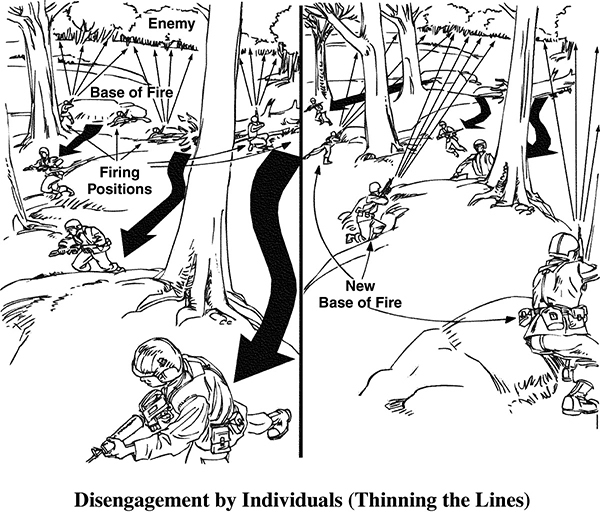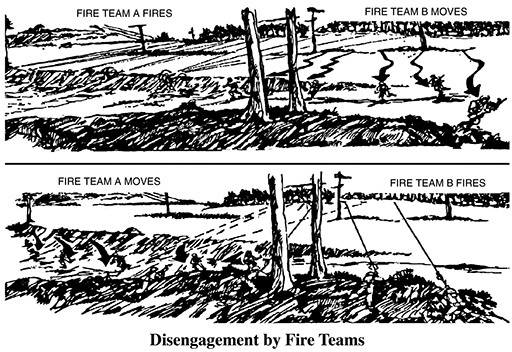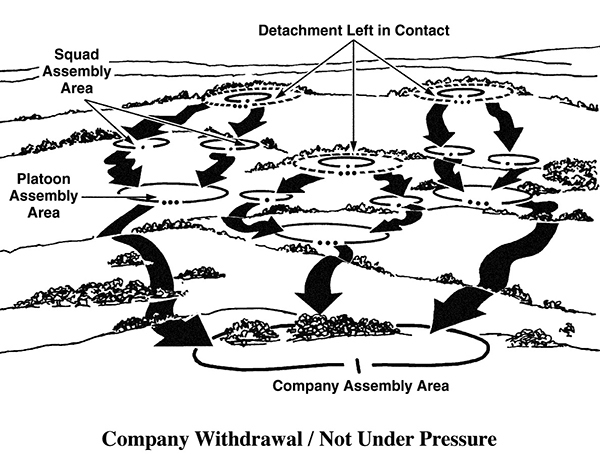•Location of attack positions or AAs (should be confirmed by reconnaissance).
•Current enemy situation.
•Obstacles.
•Stationary unit’s mission and plan (including OP, patrol, and obstacle locations).
•Location of movement routes, contact points, and passage points and lanes. (Note: The use of GPS waypoints will simplify this process and speed the passage.)
•Guide requirements.
•Order of march.
•Anticipated actions on enemy contact.
•Requirements for supporting direct and indirect fires, including the location.
•NBC conditions.
•Available CS and CSS assets and their locations.
•Radio frequencies and near and far recognition signals.
•Criteria for and location of the battle handover.
In a forward passage, the passing unit first moves to an AA or an attack position behind the stationary unit. Designated liaison personnel move forward to link up with guides and confirm coordination information with the stationary unit. Guides from the stationary unit lead the passing elements through the passage lane. In a rearward passage of lines, the risk of fratricide is increased, so coordination of recognition signals and fire restrictions is critical.
RELIEF IN PLACE
A relief in place may be needed to maintain combat effectiveness during prolonged combat operations. A relief in place is an operation in which a platoon is replaced in combat by another platoon. The incoming platoon assumes responsibility for the combat mission and assigned sector or zone of action of the outgoing platoon.
Coordination
Platoon responsibility is usually limited to the detailed coordination between key personnel and their counterparts.
Leaders must reconnoiter different routes into and out of the position; assembly area; logistics points; primary, alternate, and supplementary positions; obstacles; immediate terrain; and, when possible, patrol routes and OP locations. The outgoing leader must provide copies of the platoon sector sketch, fire plan, range cards for all weapons, barrier plan, minefield records, counterattack plans, and plans for any other tasks the platoon may have been ordered to perform.
Both leaders must know which method and sequence of relief has been prescribed in the higher unit order and how they will execute the plan. They are responsible for the following:
•Knowing whether their platoons will execute the relief by squads or as a complete platoon (method). Platoons may also execute the relief by occupying adjacent terrain or terrain in depth (to the rear) rather than by relieving soldiers in position.
•Knowing the order of relief (sequence) for platoons within the company.
•Coordinating the use of guides (outgoing unit provides guides to move incoming unit to positions), signals, challenge and password, and passage of responsibility for the mission and control of the platoon (normally when the majority of the incoming platoon is in place).
•Coordinating the exchange of tripods for crew-served weapons, phones or switchboards, and emplaced munitions. Platoons do not exchange radios.
•Identifying numbers, types, and location of supplies to be left behind, including sensors, construction materiel, wire, and any other items that might slow down the movement of the outgoing platoon.
Execution
During the execution, both leaders should co-locate at the outgoing platoon leader’s command post (CP). The leader of the outgoing platoon remains responsible for the defense of the area until the majority of the incoming platoon is in position. If the enemy attacks during the relief, the leader who has responsibility at the time is in control. The other leader assists with assets under his control as directed.
Squad leaders physically walk soldiers to positions and trade them out on a one-for-one basis. They allow time for outgoing soldiers to brief their reliefs on their position, range cards, and other pertinent information. Both the relieved and relieving platoons must maintain security to deny the enemy knowledge of the relief. The relieved platoon keeps local security elements in place. These elements are the last soldiers to be relieved. Both platoons observe strict communications security and maintain normal movement and activity. All leaders report completion of their portion of the relief as soon as possible.
WITHDRAWAL
In a withdrawal, all or part of a deployed force voluntarily disengages from the enemy to free itself for a new mission. The mission might be to defend another position or to attack someplace else. Units withdraw either under pressure or not under pressure. Platoons have three basic methods of disengaging from the enemy: They can thin their lines (disengage by individuals) or move out either by fire teams or by squads.
Thinning the Lines. To disengage by thinning the lines, also known as disengagement by individuals, squad and team leaders direct soldiers to move rearward in buddy teams, with each soldier covering the other as they move back in turn. Smoke must be used for concealment if the soldiers are moving across open areas.
Disengagement by Fire Teams. To disengage by fire teams, one team fires while the other one moves, alternating roles. This method can be used if thinning the lines is not needed because enemy fire is light or teams have already moved back far enough.
Disengagement by Squads. To disengage by squads, the platoon leader has each squad move back in turn, covered by the fire of the others. The platoon moves back by squads if thinning the lines or maneuver by fire teams is not needed because enemy fire is light or squads have already moved back sufficiently.
Withdrawal Not Under Pressure
Withdrawal not under pressure is conducted with speed, secrecy, and deception, and is best performed at night or during periods of reduced visibility. The company disengages and moves to the rear while the enemy is not attacking. The company leaves a detachment left in contact (DLIC) as a security force to cover the withdrawal by deception, fire, or maneuver. A platoon or one squad from each platoon serves as the DLIC. The composite platoon is normally the best method because there is less repositioning involved. As the DLIC, platoons perform the following:
•Reposition squads and weapons to cover the company’s withdrawal.
•Reposition a squad in each of the other platoon positions to cover the most dangerous avenue of approach into the area.
•Continue the normal operating pattern of the company.



•Cover the company withdrawal by fire if the company is attacked during withdrawal.
•Withdraw once the company is at its next position. If under contact, the DLIC might have to maneuver to the rear until contact is broken, then assemble to move to the company.
Withdrawal Under Pressure
The amount of enemy pressure determines how this withdrawal is conducted. If it is not possible to prepare and position the security force, the platoon conducts a fighting withdrawal. The platoon disengages from the enemy by maneuvering to the rear. Soldiers, fire teams, and squads not in contact are withdrawn first so they can provide suppressive fires to allow the soldiers, teams, or squads in contact to withdraw. If enemy pressure is light enough to permit a security force, a platoon (or a composite platoon) repositions itself to fight the enemy as the rest of the company withdraws.
DELAY
In a delay, the enemy slows its movement when the platoon forces him to repeatedly deploy for the attack. After causing the enemy to deploy, the delaying force withdraws to new positions. The squads or sections and platoons disengage from the enemy as described in a withdrawal under pressure and move directly to their next position, where they defend again. The squads and platoons slow the advance of the enemy by causing casualties and equipment losses by employing ambushes, snipers, obstacles, minefields (including phony minefields), and artillery and mortar fire.